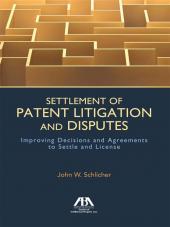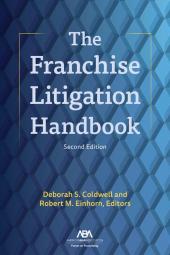Settlement of Patent Litigation and Disputes
Select a format
 International Order Inquiry
International Order Inquiry
Select subscription type
Terms & conditions
Subscribers receive the product(s) listed on the Order Form and any Updates made available during the annual subscription period. Shipping and handling fees are not included in the annual price.
Subscribers are advised of the number of Updates that were made to the particular publication the prior year. The number of Updates may vary due to developments in the law and other publishing issues, but subscribers may use this as a rough estimate of future shipments. Subscribers may call Customer Support at 800-833-9844 for additional information.
Subscribers may cancel this subscription by: calling Customer Support at 800-833-9844; emailing customer.support@lexisnexis.com; or returning the invoice marked "CANCEL".
If subscribers cancel within 30 days after the product is ordered or received and return the product at their expense, then they will receive a full credit of the price for the annual subscription.
If subscribers cancel between 31 and 60 days after the invoice date and return the product at their expense, then they will receive a 5/6th credit of the price for the annual subscription. No credit will be given for cancellations more than 60 days after the invoice date. To receive any credit, subscriber must return all product(s) shipped during the year at their expense within the applicable cancellation period listed above.
The total price includes the product(s) listed in the Order Form and any Updates for a limited period (minimum period of 30 days) after the order is placed ("Order Window"). Shipping and handling fees are not included in the grand total price.
All shipments may be returned, at subscribers' expense, for full credit of the Price within 30 days of receipt.
Shipments may not be returned, and no credits will be issued, more than 30 days after receipt.
After the Order Window, subscribers will receive notice of Updates along with the then-current grand total price and order process as Updates become available. Subscribers will only be shipped those Updates they specifically request.
Product description
View a sample of this title using the ReadNow feature
The First Book Devoted to Settlement of Patent Disputes. There two reasons for a book devoted to settlement of patent disputes and litigation. One is that settlement is more important than litigation. The effects of patents on people and businesses are overwhelmingly defined by the terms of settlement and license agreements and only rarely by judicial decisions. The other is that the subject of patent settlements has not received the attention it deserves. There are many books on litigation and licensing. Until now, there was no book directed to settlement. Organized in four sections, this resource is designed to help everyone involved improve patent settlement outcomes and processes. Throughout the book, numerous charts and graphs demonstrate the book's key concepts and pertinent data. Many charts are shown in color for ease of use.
Economics of Settlement. Business people deal with patents primarily based on economic results. They decide between litigation and a variety of possible settlements based on which is more efficient, that is, provides the largest gains at the lowest cost given a considerable amount of risk. Hence, Part 1 describes the generally-accepted economic model of settlement decisions adapted to fit patent actions and the settlement options most commonly used in the patent context. Part 1 also describes a model of the decision to license, one possible component of settlement.
Applying the Economic Model. Part 2 shows how this model is applied to help make settlement decisions in particular situations. It explains how to identify the specific facts and estimates that shape each party's settlement decision and translate that information into dollar amounts showing whether various types of settlement are in the economic interests of the parties. Part 2 contains many examples. It shows how to prepare understandable, informative charts showing the dollar magnitudes of the controlling factors from the perspectives of each party, whether the conditions for settlement are likely to be satisfied, and either the financial gap preventing an agreement or the range of financial terms within which settlement is possible. The charts are also useful in managing litigation.
Data on Patent Litigation. Part 3 describes the data the author has developed on how patent litigation works. This data will help people form reasonable expectations about litigation. How frequently are patent actions resolved by trial, pretrial motion, or settlement? How long does it take for patent actions to be resolved by trial, motion, or settlement? When does settlement usually occur? Who wins and loses on trials and motions? Are patent owners as successful as often reported? Did the Court of Appeals for the Federal Circuit really make much difference? Are damages in patent actions as large as advertised and large enough to explain the large number of actions the parties litigated rather than settled? Part 3 also describes data developed by others.
Legal Issues and Settlement. Part 4 describes the law that people involved in settlement need to understand. Law governs the consequences of various ways of resolving patent disputes before litigation and the ways litigation may be terminated. Law defines when potential infringers and licensees may commence declaratory judgment actions, creating barriers to negotiations and agreements. Antirust law defines the legality of settlement and cooperation among patent owners, accused infringers or potential licensees regarding litigation, settlement and licensing. Part 4 describes these laws and ways to adapt settlement practices to the constraints of the law.
eBooks, CDs, downloadable content, and software purchases are noncancelable, nonrefundable and nonreturnable. Click here for more information about LexisNexis eBooks. The eBook versions of this title may feature links to Lexis+® for further legal research options. A valid subscription to Lexis+® is required to access this content.
 Lexis Nexis
Lexis Nexis 
